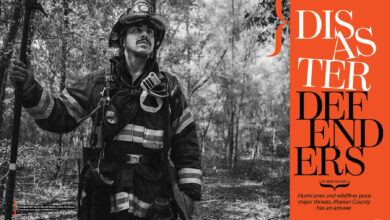Written by Kelli Fuqua Hart, Ocala Magazine Executive Editor | Photography by Chris Redd, Chief Photographer
We anxiously watch, biting our nails and partially covering our eyes, the person in pursuit of that creaking sound, that unsettling noise in the attic, that eerie rustling of bushes. With our fists clenched tight we yell, “Don’t go in there!” It’s far too late. The subject has met its nightmare and with dimly lit flashes of shadowy figures, we piece together what only the imagination can conjure. and we love every heart pounding minute of it.
There is an element of fear that fascinates mankind. “Horror is one of those genres that have a seemingly inexhaustible supply of audience,” said Paul Dergarabedian, president of Exhibitor Relations Co, a box-office tracking firm. Additionally, because Fear takes the lead role, moviegoers are not as concerned about the cast as they would in a romantic comedy or drama. Skirting around having to shell out big bucks for A-list celebs, horror producers have a much lower overhead, meaning a much larger profit in almost all cases.
For example, Saw made its debut in 2004 and took the nation by storm. The biggest name in that cast belongs to Cary Elwes, who is relatively known. Saw cost first time writer and director James Wan a whopping $1.2 million to make but generated over $55 million in box office receipts in the US.
In 2014 alone, over $450 million was spent on horror flicks at the box office in the United States. Another $7.4 billion, yes billion, was spent by consumers on Halloween related merchandise. I believe it is safe to say Americans spare no expense when it comes to indulging in things that go bump in the night.
Having the daylights scared out of us causes our heart to rapidly beat almost out of our chest. Our breathing intensifies and the body pours sweat. We tend to hold ourselves closer to ourselves as if to not let the monster reach into our souls and hollow it out. Teeth clenched and eyes squeezed shut, we can barely stand the thought of what is certain to appear at the end of that dark, cold hallway. Hairs stand up on the backs of our necks and the will to scream seems to be lodged in our throats. We are terrified –– petrified –– and we love it. Why?
Ocala’s Bronson Mosley, CEO and Founder at Day Break Studios, Inc. shed some light on why many people are inherently fascinated with fear. Mosley writes, produces and directs Wes Craven type nightmares and understands the underlying desire to be scared to death.
Mosley discerns, “A fascination with fear has always existed in human nature, visible in ancient civilizations and governed by apprehension to the current day culture’s insatiable appetite for shock-value situations. While it has remained a staple throughout our stay on the planet earth, with every passing generation of people there seems to be deeper and darker definition of what exactly fear means.
Why is it that we continue to dive into ourselves to discover what makes us uncomfortable or even repulsed? What is it about those terrible feelings that draws us to recreate them? How is we could possibly find entertainment, enjoyment, or possibly satisfaction from our innate phobias?
The growing obsession with these terror-driven experiences that our modern society exhibits exists for the same reasons in graphic horror cinema as it does in evolving extreme sports and experimental roller-coasters. The world has rapidly grown through technological advancement and in this renaissance we have been granted almost limitless access to information and communications. We have gotten our grips on just about every type of hard-hitting, eye-popping- and heart-racing adventure that the human mind can create. We’ve tasted the finest of fears, essentially setting the bar for what we consider to be scare-worthy.
When will our fascination with the deadly and dangerous finally hit its plateau? If history has taught us anything about humanity and fear it is simply that these two elements will always continue to evolve throughout time – one growing mightier and the other seeking to challenge that strength.”
Local fear-seeker and horror fein Chris Rosenfal shared why he believes people are so consumed with the thrill of terror. “We live in a world where things are mainly routine. Same thing, day in and day out. When an opportunity arises for something bizarre – something peculiar and bewildering – curiosity kicks in.” People are intrigued by the unknown and sometimes the unknown is cloaked in something dangerous and wicked.
The Psychology of Fear
Per Psychology Today, Fear is a vital response to physical and emotional danger — if we didn’t feel it, we couldn’t protect ourselves from legitimate threats.” It provides us the automatic ability to fight or flight when we are threatened. Fear itself is necessary to survive. What about the people who seek fear, those who enjoy the thrill of fright and the heart pounding anticipation that precedes a scream? Why is this one nation under God so obsessed when it comes to fear, fright and everything that scares the hell out of us?
First, there are physical changes that occur in our frightened bodies that often stimulate the senses. Much like when we sense danger, cortisol (the stress hormone) begins pumping as well as adrenaline. For example, the classic creepy girl in white appears out of nowhere. That ghostly girl acts as a stimulus, triggering a clear signal to your brain. (Ok, here comes a little bit of science, so bear with me).
That signal immediately travels to the amygdala near the base of the brain. The amygdala releases glutamate, a brain chemical, to two specific regions of the brain. One of those regions causes us to automatically freeze or jump – with little to no control over the behavior. The other region, the hypothalamus, is responsible for flight or fight. This is what causes the elevation in heart rate and rise in blood pressure as mentioned above. It’s the rush – the surge – horror evokes.
For over 20 years, Glenn Sparks, PhD, has researched human responses to terrifying images in the media. “Some people have a need to expose themselves to sensations that are different from the routine,” Sparks says. “While experiencing a frightening movie may have some negatives, individuals often derive gratification because the experience is different.”
Sparks concluded that males appreciate scary films more than females, but it’s not necessarily because they enjoy being scared. There is a sense of pride that males feel having “…conquered and mastered something that was threatening.” The consensus remains, when a terrifying film ends, both men and women thrill-seekers have a profound sense of relief, happy the movie is over.
“Type T” Personalities
Speaking of thrill-seekers, Frank Farley, PhD, psychologist at Temple University and former president of the American Psychological Association, has studied individuals who are labeled “type T” (thrill-seeking) personalities. The type T person, according to Farley, “thrives on the uncertainty and the intensity associated with activities that most people consider to be hair-raising.”
Farley’s conclusion mirrors Sparks in that some people simply enjoy the physical sensations that come with being scared. He is certain for some type Ts, nothing can match the feeling of fear, “…in terms of the incredible sensory experience that the body is put through,…” including sex!
Scared Straight
Because the physical effects of fear and fright are real, it is easy for some individuals to have a very real, very lasting impression from movies and experiences that literally scare them silly. About one-third of the population has been left frozen with fear after an experience so horrifying that they could not snap out of their panic. For example, one woman in her late thirties watched Silence of the Lambs and could not eat meat for the following six months. Several adults who watched The Exorcist when it was first released ended up hospitalized due to extremely high levels of emotional and psychological distress.
An extreme opposite does exist. There are those people who can’t be satisfied by basic horror movies, themed haunts or devilish tales. Like an itch that can’t be scratched, these people can’t be scared enough – they need more. Luckily, there is a Designer Kidnapping service where clients can pay upwards of $4000 to be abducted, tied up, gagged and confined for days, should one so choose. If that’s not enough, a person’s experience can be customized to include as much terror and torture as desired.
Who would do this you ask? Surprisingly, many people have forked over the funds to be snatched from a bus stop or bedroom, tossed into an unknown backseat, gagged, bound, stripped of their clothing and thrown around like a rag doll, all to satisfy some masochistic fantasy. It is a serious business. Interviews are conducted, fears spelled out and contracts signed. Farley concludes, “I view this as a very decadent indulgence. It’s violent and very scary, but people do it voluntarily.”
What Scares Us Most?
Is it sadistic killers or a planet crawling with zombies that sends us screaming most? For some, it’s psychotic clowns and monsters in the closet that rev up the excitement. For others, it’s what is real, or what could be real, that sends us screaming. For example, research conducted by Psychology Today concluded most individuals are frightened by the mere idea of something horrifying happening – something far-fetched but possible. The serial killing hitchhiker, the sociopathic roommate, the mad scientist who performs sadistic experiments on unsuspecting victims – all terrifying and all very realistic.
Psychology Today’s findings resulted in a list of of the top ten themes that make a horror story, well, horrific.
Coming in at number 10 is fear of the unusual – an otherwise innocent doll or children’s clown turned petrifying. The list continues with lightening and thunder, spooky music, suspense, dismemberment, disfigurement, scary places, creepy crawly things, the dark and, at first place, the fear of death. Because after all, it’s not true horror until someone dies.
Based solely on this list there is clear evidence people are less frightened by fantasy and far-fetched fear than they are those scenarios that are humanly possible. Maybe this is why Americans are obsessed with violent news stories and sadistic headlines? – real life horror stories that evoke masochistic curiosity.
With Halloween upon us, it is a great time to have an affair with fear. Whether you are already a lover of things that lurk or eager to dance with the devil, October is full of opportunities. So awaken your inner demons, chase a mysterious echo down a dark path, explore what some call evil and hope to God you survive it all!






